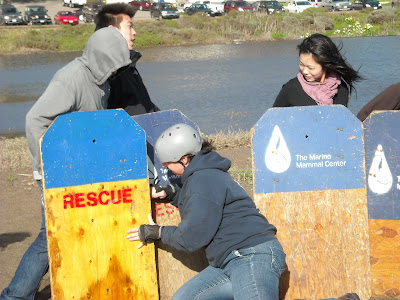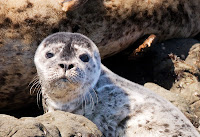 | |||||||||
| Marine Mammal Center Volunteer Training Rodeo Beach, February 7 2010 |
I was also struck by how useful the Marine Mammal Center's training materials could be for families living along the California coast. Volunteers were treated to slide after slide of each pinniped species, and the narrative input from the Center's experts further helped us to identify characteristics and behaviors unique to each species.
It occurred to me that families along any coast have a unique role to play in helping marine mammals survive and thrive. We share our beaches with these glorious creatures, and they bring us important news bites from the sea that reveal the current health of our coastal waters. It is not lost on me that the Marine Mammal Center saves these animals on a regular basis, but in turn, as we learn details from the Center's research, we are equipped with the information we need to save ourselves.
 |
| Young Harbor seal pup / Credit Stan Keiser |
If it is not certain that an animal requires veterinarian care, the Marine Mammal Center will place that animal under 24-hour observation to try to learn more about its condition. But if an animal looks malnourished or stressed, all one has to do is call the Marine Mammal Center Hotline at 415.289.SEAL and the Center will dispatch one of their trucks and conduct a rescue. The Marine Mammal Center's rescue range extends along 600 miles of central and northern California coastline, from San Luis Obispo through Mendocino County.
Would that all wild animals had such wonderful care!



No comments:
Post a Comment